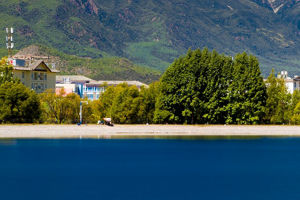Salt pans are places where salt is extracted by evaporation. Originating between 5000 BC and 3000 BC, salt pans are mainly made from sea salt, but there are also salt pans inland.
The millennia-old salt fields of Tibet's Yanjing, are the oldest and best-preserved salt pans in China. From the appearance, the salt pans are scattered like chocolate in the Lancang River Valley. Located on the east and west banks of the Lancang River in Yanjing Town, Mangkang County, Tibet Autonomous Region, the ancient salt pans have a history of 1,300 years. They are the sole region in China where the manual method of salt production persists, with over 3,000 salt pans in operation today.
It was once an important post on the ancient Tea Horse Road, witnessing the glorious past of Tibet. Now long time has erased the former prosperity of this trade route, but left Tibet's only salt-producing area, became a valuable cultural heritage, and made people proud.
The ancient salt pans are located in the southeast of the Tibet Autonomous Region. The area is surrounded by mountains and deep valleys, which provide favorable geographical factors for the formation of salt pans. Under the influence of the Hengduan Mountain fault, the underground aquifer will flow from the fault near the surface, thus forming salt Wells.
For millennia, saltwater has continuously flowed from salt wells. People have constructed salt pans adjacent to these wells to produce salt, creating a rare cultural landscape in Tibetan regions.
Each salt pan here is about 5 square meters. The salt pans are raised into the mountains, covered with clay, and supported by sticks below. If we stand at the bottom of the salt pan and look up, we can still see columns of salt crystallized by salt drops. Every winter, local villagers gather soil from the mountains to repair and fortify the salt pans, ensuring a bountiful salt harvest in the following year.
There are currently 3,454 salt pans, each producing about a dozen kilograms of salt. Salt was made in a very primitive way, by draining the brine into a salt pan, and then blowing and drying it to evaporate the water, and the salt grains were formed.
With the rise of tourism, more and more tourists come here. The reason why Yanjing Millennium Ancient Salt Field attracts so many tourists is not only its history and culture of salt production in ancient ways but also its unique beauty like a "mirror in the sky".
Mankang ancient salt field is a unique cultural landscape in the world. The unique primitive way of producing salt here and the special geographical environment form a world wonder. In recent years, foreign experts and scholars have visited the ancient salt pans. They generally agree that the salt pans should be a world-class cultural heritage.
Today, the salt field has been included in the Preliminary List of China's World Cultural Heritage. While inheriting the original memory, the ancient salt pan inherits the history and records the brilliance with its unchanged form and appearance for thousands of years.


